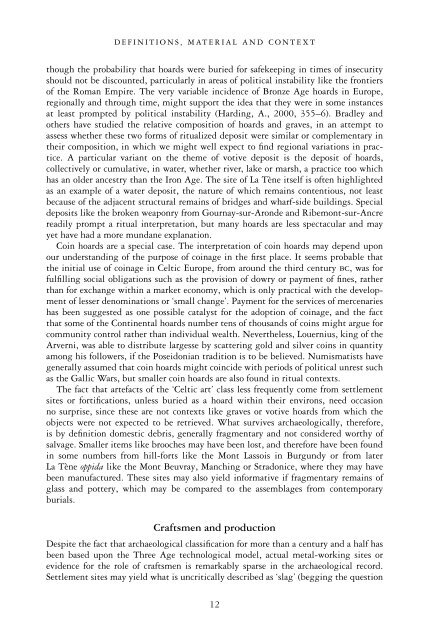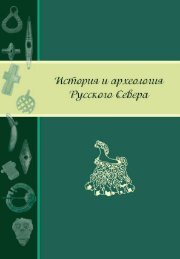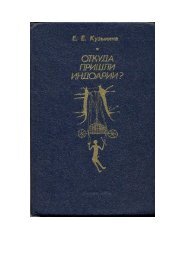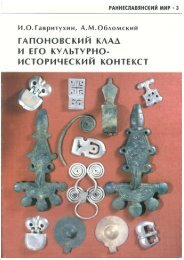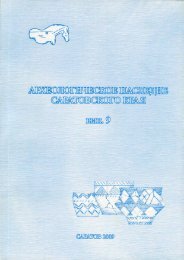The Archaeology of Celtic Art
The Archaeology of Celtic Art
The Archaeology of Celtic Art
- No tags were found...
Create successful ePaper yourself
Turn your PDF publications into a flip-book with our unique Google optimized e-Paper software.
DEFINITIONS, MATERIAL AND CONTEXTthough the probability that hoards were buried for safekeeping in times <strong>of</strong> insecurityshould not be discounted, particularly in areas <strong>of</strong> political instability like the frontiers<strong>of</strong> the Roman Empire. <strong>The</strong> very variable incidence <strong>of</strong> Bronze Age hoards in Europe,regionally and through time, might support the idea that they were in some instancesat least prompted by political instability (Harding, A., 2000, 355–6). Bradley andothers have studied the relative composition <strong>of</strong> hoards and graves, in an attempt toassess whether these two forms <strong>of</strong> ritualized deposit were similar or complementary intheir composition, in which we might well expect to find regional variations in practice.A particular variant on the theme <strong>of</strong> votive deposit is the deposit <strong>of</strong> hoards,collectively or cumulative, in water, whether river, lake or marsh, a practice too whichhas an older ancestry than the Iron Age. <strong>The</strong> site <strong>of</strong> La Tène itself is <strong>of</strong>ten highlightedas an example <strong>of</strong> a water deposit, the nature <strong>of</strong> which remains contentious, not leastbecause <strong>of</strong> the adjacent structural remains <strong>of</strong> bridges and wharf-side buildings. Specialdeposits like the broken weaponry from Gournay-sur-Aronde and Ribemont-sur-Ancrereadily prompt a ritual interpretation, but many hoards are less spectacular and mayyet have had a more mundane explanation.Coin hoards are a special case. <strong>The</strong> interpretation <strong>of</strong> coin hoards may depend uponour understanding <strong>of</strong> the purpose <strong>of</strong> coinage in the first place. It seems probable thatthe initial use <strong>of</strong> coinage in <strong>Celtic</strong> Europe, from around the third century bc, was forfulfilling social obligations such as the provision <strong>of</strong> dowry or payment <strong>of</strong> fines, ratherthan for exchange within a market economy, which is only practical with the development<strong>of</strong> lesser denominations or ‘small change’. Payment for the services <strong>of</strong> mercenarieshas been suggested as one possible catalyst for the adoption <strong>of</strong> coinage, and the factthat some <strong>of</strong> the Continental hoards number tens <strong>of</strong> thousands <strong>of</strong> coins might argue forcommunity control rather than individual wealth. Nevertheless, Louernius, king <strong>of</strong> theArverni, was able to distribute largesse by scattering gold and silver coins in quantityamong his followers, if the Poseidonian tradition is to be believed. Numismatists havegenerally assumed that coin hoards might coincide with periods <strong>of</strong> political unrest suchas the Gallic Wars, but smaller coin hoards are also found in ritual contexts.<strong>The</strong> fact that artefacts <strong>of</strong> the ‘<strong>Celtic</strong> art’ class less frequently come from settlementsites or fortifications, unless buried as a hoard within their environs, need occasionno surprise, since these are not contexts like graves or votive hoards from which theobjects were not expected to be retrieved. What survives archaeologically, therefore,is by definition domestic debris, generally fragmentary and not considered worthy <strong>of</strong>salvage. Smaller items like brooches may have been lost, and therefore have been foundin some numbers from hill-forts like the Mont Lassois in Burgundy or from laterLa Tène oppida like the Mont Beuvray, Manching or Stradonice, where they may havebeen manufactured. <strong>The</strong>se sites may also yield informative if fragmentary remains <strong>of</strong>glass and pottery, which may be compared to the assemblages from contemporaryburials.Craftsmen and productionDespite the fact that archaeological classification for more than a century and a half hasbeen based upon the Three Age technological model, actual metal-working sites orevidence for the role <strong>of</strong> craftsmen is remarkably sparse in the archaeological record.Settlement sites may yield what is uncritically described as ‘slag’ (begging the question12


